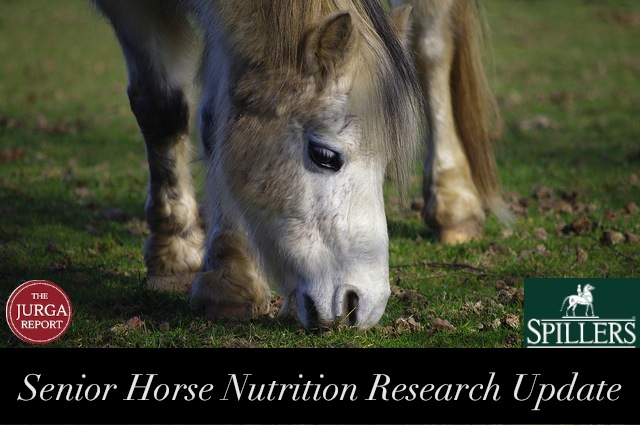
Horses and ponies are living longer and advances in equine nutrition, as well as improved management and veterinary care, are continuing to play a key role in increasing longevity, particularly for those suffering from conditions such as Pituitary Pars Intermedia Dysfunction (PPID), which is also known as equine Cushing’s disease.
The British feed company SPILLERS®, through the WALTHAM® Equine Studies Group, is actively participating in important research to find the best nutritional support for senior horses, whether they are healthy or diagnosed with PPID. The group has recently completed two significant studies in this area and has a further two confirmed for 2015.

The Group recently published two scientific papers and has presented some early research at an international geriatric equine workshop on feeding the senior horse:
A comparison of nutrient digestibility between adult and aged horses, conducted by the Department of Large Animal Clinical Sciences and Animal Science, Michigan State University, USA and The WALTHAM® Equine Studies Group, confirmed, in contrast to earlier work, that there was no difference in digestibility between healthy adult and aged horses when fed a variety of common equine diets.1
Characterization of the fecal bacterial community in adult and elderly horses fed a high fibre high oil or high starch diet, conducted by the Institute of Biological Environmental and Rural Sciences, Aberystwyth University in Wales, The WALTHAM® Equine Studies Group and Michigan State University, used the same horses as the previous study but this time looked at their gut microflora.
The results in the second study showed that, although no significant differences in individual species of bacteria were found, aging was, however, associated with a reduction in bacterial diversity. This may explain, in part, why older animals can be at increased risk of intestinal disturbances.2
An abstract that summarized part of the WALTHAM® Equine Studies Group’s work on the effect of additional supplementation on aged horses with and without PPID was presented at the Havemeyer Geriatrics 2 Workshop in the USA last November.3 This work, carried out in conjunction with Dr Amanda Adams at the University of Kentucky showed that age is key in influencing inflammation and metabolism rather than whether the horse is PPID positive or not.
Professor Pat Harris, head of the WALTHAM® Equine Studies Group, explained: “For the parameters we monitored, the research showed that it is being old that is the issue, rather than having PPID.”
This year the Group will focus on two projects:
- Under the supervision of Professor Caroline Argo of the University of Surrey, in collaboration with the University of Liverpool Equine Hospital and the University of Aberystwyth, we will look further at the nutritional management of senior (>20 years) and obese animals. We will explore the effects of diet on the gut microflora and examine how this information can be used to improve advice on their feeding and management.
- Work in collaboration with Professor Ray Geor will also be carried out at the College of Veterinary Medicine, Michigan State University, USA to explore how best to feed the older horse with respect to insulin responsiveness and the ability to manage glucose and starch.
Clare Barfoot, RNutr, research and development manager at SPILLERS®, said: “This should give us a better understanding of the effects of diet and age on metabolism in order to determine optimal nutrition for the senior horse. Preliminary work suggests that this new research may change the way we think of feeding the older horse. WALTHAM’s® work continues to ensure that SPILLERS® feeds remain at the forefront of equine nutrition, for the better health of horses everywhere.”
1Elzinga, S., Nielsen, B.D., Schott II, H.C., Rapson, J., Robison, C.I., McCutcheon, J., Harris, P.A., Geor, R (2014) Comparison of Nutrient Digestibility Between Adult and Aged HorsesJournal of Equine Veterinary Science,34(10), pp.1164-1169.
2Dougal K, de la Fuente G, Harris P, Girdwood SE, Pinloche E, et al. (2014) Characterisation of the Faecal Bacterial Community in Adult and Elderly Horses Fed a High Fibre, High Oil or High Starch Diet Using 454 Pyrosequencing.PLoS ONE 9(2): e87424. doi:10.1371/journal.pone.0087424
3Betancourt A, Harris PA, Moffett AD, McMurry KE, Reedy SE, Horohov DW, Adam AA (2014) Comparison of inflammation, nutritional status, muscle mass, pituitary function, and age in geriatric horses.
Note: The paper in reference (2) is published in an open-access journal and can be access and downloaded without charge from either PubMed or PLoS ONE.
Information for this article was provided by Spillers.








